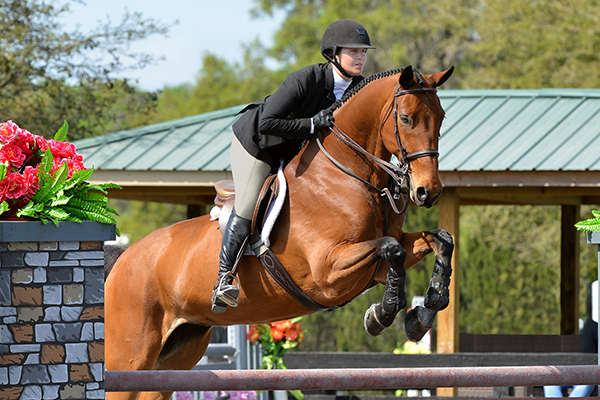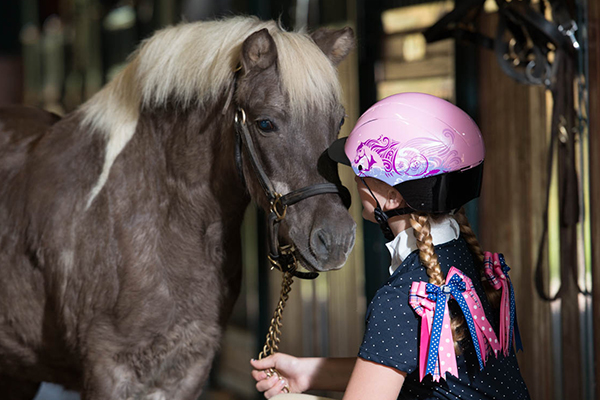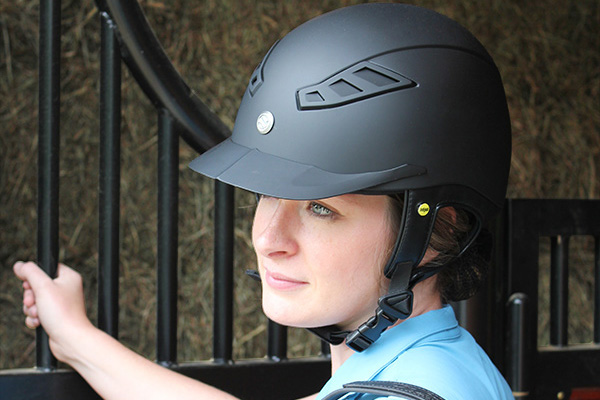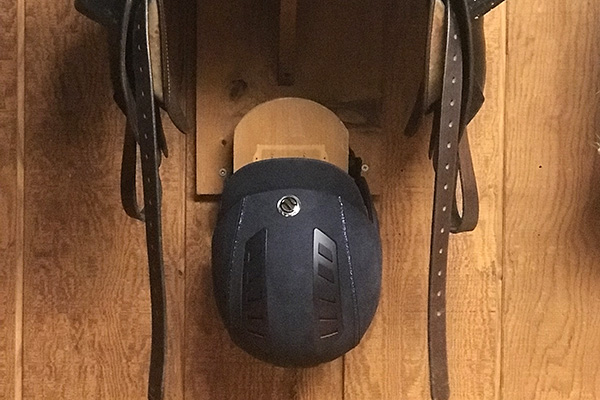
Helmets are an essential piece of safety equipment for every equestrian. Protecting against concussions, traumatic brain injuries (TBIs), skull fractures, lacerations, and fatal injuries, helmets are worn by equestrians of every discipline… including driving! According to Lyndsey White at Riders4Helmets, wearing a helmet could reduce the risk of riding-related head injury by an estimated 50 percent, as well as the risk of death due to head injury by a whopping 70-80 percent.
With a wide array of helmet brands, styles, and options, it can be difficult to determine which helmet is right for you. Keep reading to learn more about helmets and how to select the correct helmet for you.
Safety First!
All of the helmets that we carry at The Cheshire Horse are American Society for Testing and Materials (ASTM) and Safety Equipment Institute (SEI) certified. Helmets which are ASTM/SEI certified have passed rigorous testing (impact, side distortion, and penetration tests) to ensure that they will appropriately protect the wearer’s head in the event of a fall.

In addition to being the safest helmets on the market, many events, including those sanctioned by the United States Dressage Federation (USDF), United States Hunter/Jumper Association (USHJA), Pony Club, and 4-H, require that all mounted riders as well as equestrians who are driving a cart wear a certified helmet. Refer to your association’s rulebook when purchasing a helmet for competitions, to ensure that it is legal equipment. Even though certified equestrian helmets may not be required for certain divisions, such as saddle seat and Western pleasure, they are legal to wear in all United States Equestrian Federation (USEF) classes.
All Shapes and Sizes
When purchasing a helmet, fit is the most important factor. Make sure that wear your hair in a similar fashion as you plan to ride, for example in a bun or ponytail, when trying on helmets. If you typically wear your hair under your helmet, bring a hairnet with you so that you can put your hair up prior to trying on helmets.

A helmet should fit snugly, but it should not pinch the wearer’s head or create painful pressure points. Our blog post Fitting Your Riding Helmet explains the finer points of properly fitting a helmet.
The shape of your head is an important factor to consider when shopping for helmets. Some equestrians have a round head shape, while others have a more oval shape head. Helmets are available in various shapes, so it makes sense to try on several helmets until you have the right fit. Typically, Ovation Helmets and IRH helmets are known for their oval shape, while GPA and Trauma Void helmets fit heads with rounder proportions. Some helmet manufacturers, such as Charles Owen and One K offer round, oval, and long oval shape options.
Dial It In
If you are helmet shopping for a young equestrian, you may be tempted to buy a helmet with “room to grow.” We caution against this, since a helmet that does not fit properly cannot protect your child’s head as it was designed to.
For children that are growing rapidly, we encourage parents or guardians to purchase a helmet that features an adjustable dial, such as Troxel’s DialFit System. This allows you to adjust the size of the helmet and provide a custom fit for each rider. These helmets literally grow with your child!

We also love helmets with adjustable dials for riding schools that have helmets available for their students. The dial ensures that everyone will be riding with a helmet that fits their head correctly.
Options, Options, Options!
With so many exterior options on the market, it can be difficult to determine which one is right for you. Currently, a smooth plastic or thin microfiber exterior is the most popular among our customers. This helps the helmet to repel dust and dirt, and it is extremely easy to clean. There are a number of different exteriors on the market; Ovation helmets, the many Troxel helmets, and Trauma Void helmets all have an outer shell that is molded from acrylonitrile butadiene styrene (ABS) thermoplastic. Lyndsay tells us, “ABS thermoplastic is a proven material for structural applications when impact resistance, strength, and stiffness are required, such as a helmet.” For competition riders looking for a show helmet, we recommend selecting a black, dark gray, or navy helmet.
When purchasing a schooling helmet, feel free to have some fun! There are a number of color options available, from matte black to glossy bright pink. Some helmets, such as the Troxel Legacy Helmet or the Troxel Fallon Taylor Helmet, feature bold, unique patterns and designs.

For those that prefer a classic look, don’t fret. We still carry a number velour coated helmets, including the Charles Owen Hampton Helmet and the IRH Medalist Helmet.
New Technology
New advances are constantly being made in equestrian safety. One of the newest pieces of technology is the introduction of the Multi-Directional Impact Protection System (MIPS). Skiers, snowboarders, and mountain bikers have relied on this technology for decades, and it has recently entered the equestrian scene.
MIPS technology simulates the way that the scalp slides in response to force in an effort to protect the skull and the brain. In these helmets, an inner shell shifts to minimize impact in the event of a fall. For a more in-depth view into MIPS technology and how you can benefit from it, refer to our blog, An Introduction to MIPS Equestrian Helmet Technology.

Some helmets, including the Trauma Void EQ3 Helmet and the Charles Owen My PS Helmet, integrate MIPS into their ASTM/SEI certified helmets for a well-rounded approach to safety.
Time for a Change
After you have purchased the perfect equestrian helmet for you, it is important to note that your helmet quite simply won’t last forever. Due to the degradation of the foam, padding, and other components, helmet manufacturers recommend that you replace your helmet every five years.
There is, however, a caveat to the five year rule. Helmets are only able to protect your head for one impact, they must be replaced after each fall. This also includes any falls from a shelf or drop onto a hard surface, so hold onto your helmet tight and make sure that it is stored securely and out of extreme temperatures, which may also damage your helmet. Learn more on our blog post, When It’s Time to Replace Your Helmet.

The right helmet protects your brain and skull while being comfortable to the wearer. At The Cheshire Horse, we carry an extensive selection of equestrian helmets to ensure that we can fit equestrians of every age and head size, as well as every budget. If you have any questions about which helmet is right for you, we encourage you to connect with a highly trained member of our friendly sales staff. As equestrians, we love helping you shop for all your horseback riding needs.

Hi I’m looking for a MIPS technology equestrian helmet that come is an oval shape for my daughter who is 12
Hi Karen, it sounds like you are going to want to look at the Charles Owen My PS with MIPS. Charles Owen has a handy sizing guide: https://www.charlesowen.com/guides/how-to-measure-head-riding-helmet.html.
I just purchased the Tipperary helmet with MIPS technology.
Very smart decision Maureen.
Tipperary MIPS helmets are built to fit 95% of rider head shapes. The helmets adjustment feature makes this possible while allowing the MIPS system to function at its highest level.
I currently have a One K Defender size M Long Oval helmet. I bought the Long Oval because that’s my face shape. It gives me a headache and leaves pretty large indentation across my forehead when I take it off. When I measure my head, I am 56-7 cm so the size is right. Would the Oval fit better than the long oval?
Hi Laura, thanks for your question! Please keep in mind that every helmet between brands does fit differently. We would recommend to either go a size up in the long oval (large) or try the round. Usually with the long oval you wouldn’t be having pressure on your forehead, which suggests you mind just need a bigger size (rather than different shape). If you are local and interested in coming in for a fitting, we would be happy to help you find the best size and brand for you. Alternatively you can reach out to [email protected] and we can help answer any additional questions you have. We’ve also attached a One K helmet size chart which may help: https://www.onekhelmets.com/size-chart/.
I think I need to clarify my previous comment because I was confusing to you. 🙂 I currently wear the One K Defender Medium Oval bling helmet. Love this helmet but it gives me a ginormous headache and pretty bad indentation on my forehead after riding. (I have a narrow face and measure from ear to ear 27 cm and 56 cm around my head). So, I purchased the same helmet in a LARGE OVAL. My head swam in it. Ugh. Do you think a regular Medium might fit better OR might it be the helmet liner causing an issue?